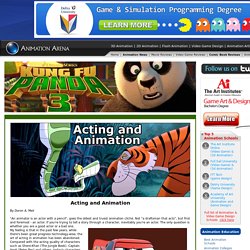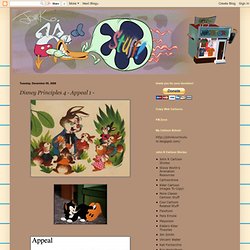

MAIN POST - TUMBLR. Acting and Animation. By Doron A.

Meir "An animator is an actor with a pencil", goes the oldest and truest animation cliché. Not "a draftsman that acts", but first and foremost - an actor. If you're trying to tell a story through a character, inevitably you're an actor. The only question is whether you are a good actor or a bad one. My feeling is that in the past few years, while there's been great progress technology-wise, the art of acting in animation has been abandoned. In the various internet forums one can find threads concerning software, design, textures - some even talk about movement - but it's rare to read something about acting. In the following article I have put on paper my thoughts considering acting in animation, which apply to any form of character animation - including 3D.
What is good acting? I. Believable acting holds a great power over the viewers, because the character they're watching gets a sort of meaning. Feel. Think. React. Lackadaisy Expressions. Boy, I didn't know what I was getting myself into when I started this.

I've had requests for some sort of expressions tutorial dating back a while now, so I figured, "Sure! I can explain expression drawing...and it'll be way better than all those tutorials out there that are nothing but charts of generic expressions. Yeah! Just give me a day or two to whip something up... " Um. Anyway, I found all I could really do was try to explain ways to teach yourself...and then add some pictures.
Character Design Principles. Powered by Google Docs. Academy of Art Character and Creature Design Notes. The Cartoon Cave: The "Freddie Moore Girl"! In my last post I referred to the "Freddie Moore Girl" in describing the type of very cute and curvy cartoon girls that you would see in some of the Disney films of the 40's and 50's.

Fred Moore was an animator who has become somewhat legendary to Disney animation aficionados over the years. He was largely self-taught, but with an innate ability to draw everything assigned to him with great visual appeal. Those who worked with him claim that he couldn't have done a bad drawing if he'd tried, so natural was his talent. I'm not going to give a whole history of Fred, suffice to say that he was the animator who really determined the final designs of the Seven Dwarfs, as well as having helped Mickey's design to constantly evolve into ever more appealing and animatable forms.
In his off time, Fred was most renowned for his numerous sketches of cute, innocently sexy young girls, which were in high demand from his many fans within Disney's animation department. Disney Principles 4 - Appeal 1 - I'm not sure, but I will try to analyze it, starting with how Disney found appeal in their style.

It'll take a few more posts though. Here are some "ingredients" of appeal, but knowing them doesn't guarantee that you can capture the subtleties and balance them to just the right degree to make your drawings look fun. Pleasing construction: Disney Appeal: Based on infant, baby animal and feminine traits. Big heads, big eyes, soft flesh - but wrapped around good construction and perspective. Proportions: cartoonists magnify the things we find interesting and shrink the things we find ugly or boring. Big heads, small bodies, big hands sometimes etc. A good cartoonist draws emotions rather than precise accuracy or realism. Personal style: Some artists just have naturally appealing styles. Animators who draw well but don't have strong appealing individual styles benefit from having good designs to work from. Moore can draw solid finished drawings as well, but that's harder to copy.